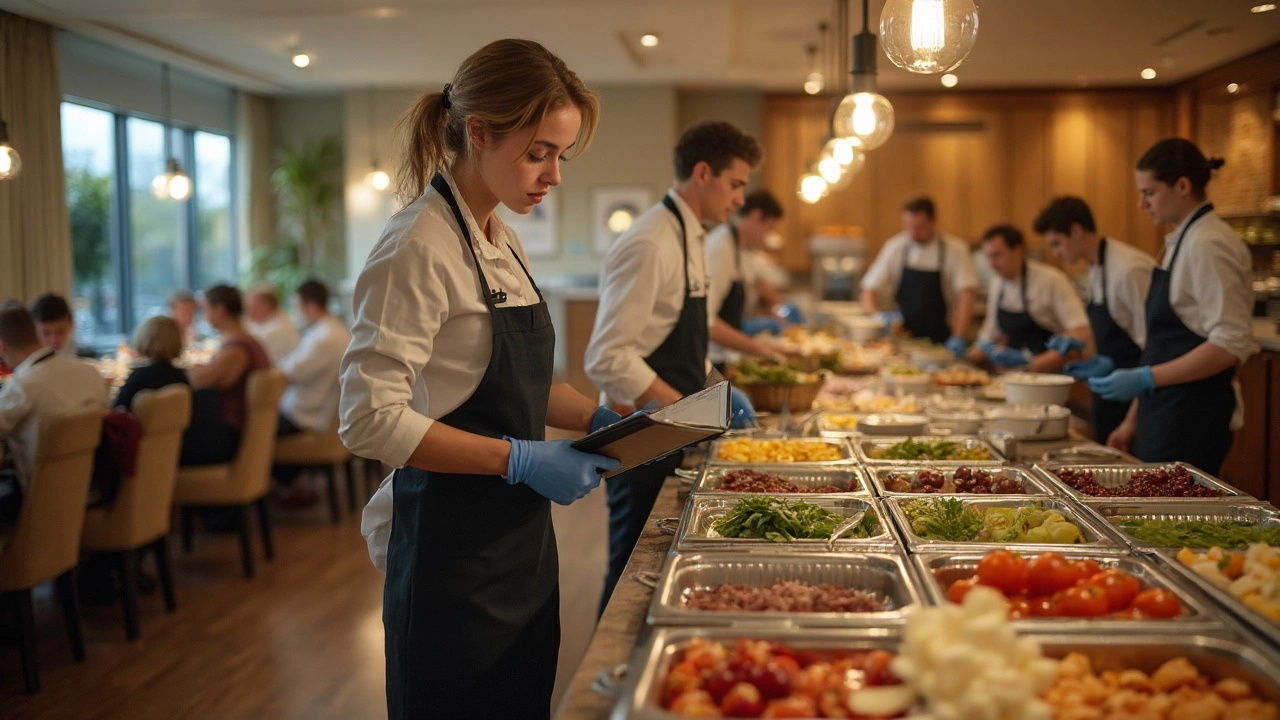What Happens to Leftover Food in All-Inclusive Hotels?
2 Jun, 2025Ever stared at a mountain of uneaten food at a hotel buffet and wondered what happens next? You’re not alone. All-inclusive hotels, with their endless trays of steaks, scrambled eggs, and pastries, produce huge amounts of leftover food every single day.
Most of it isn’t caused by guests piling their plates too high—though that definitely happens. The real issue is that hotels always prepare extra just in case there’s a sudden rush or a favorite dish runs out. Throwing out untouched food has become the norm because nobody wants the risk of serving anything less than super-fresh.
If you've ever felt a bit guilty scraping your barely tasted pancakes into the bin, you’re already ahead of the curve. Food waste is a big deal in the hotel world, both for the environment and the hotel’s bottom line. Some hotels are waking up and trying new ways to turn those leftovers into something useful instead of just tossing it all in the trash.
For anyone planning a stay at an all-inclusive resort, knowing how these places handle leftovers can shape how you see your vacation. Plus, it might even help you make a few smarter choices next time you’re facing down a towering breakfast buffet.
- Why There’s So Much Leftover Food
- What Hotels Actually Do With Leftovers
- Creative Ways Hotels Reduce Waste
- Tips for Travelers Who Care About Waste
Why There’s So Much Leftover Food
Walk into any all-inclusive resort and you’ll see buffets loaded with options: trays of eggs, piles of pastries, endless rows of meats and salads. It kind of makes sense why there’d be leftovers, but the scale is actually pretty wild. The main reason? All-inclusive hotels are all about abundance. The goal is to impress guests and make sure nobody’s ever disappointed by an empty tray, even if that means prepping way more food than anyone can actually eat.
Another big factor is unpredictability. Hotel managers can’t really guess exactly how many plates of French toast someone is going to load up at 9:15 a.m. versus 10:30, so they over-prepare just to be safe. Plus, people tend to eat more when food is “free” and within arm’s reach, which keeps demand unpredictable. Ever notice how you pile your plate higher at the buffet than you would at home?
The rules around food safety don’t help either. Once hot dishes hit the buffet, most can’t just be saved and served again—at least not safely. This means anything that sits out for a while usually gets dumped once mealtime ends. A food and beverage manager at a major hotel chain once put it like this:
“If there’s even a slight chance something’s not at peak quality, we throw it out. We just can’t risk anyone getting sick—it’s not worth it.”
Let’s talk numbers. Here’s a quick look at food waste in all-inclusive hotels compared with other food businesses:
| Type of Establishment | Food Waste per Day (kg) | Per Guest per Day (kg) |
|---|---|---|
| All-Inclusive Resort Hotel | 350-500 | 0.7-1.1 |
| Standard Restaurant | 50-100 | 0.2-0.4 |
| Fast Food Restaurant | 30-75 | 0.1-0.3 |
Buffets also run longer hours and offer more variety than most restaurants, which means keeping a lot of dishes topped up—just in case. You can see how it all adds up fast. The pressure to please and the unpredictability of guest habits make food waste almost impossible to avoid in these places.
What Hotels Actually Do With Leftovers
Here’s the real deal behind those trays of untouched lasagna and yesterday’s salad: most all-inclusive hotels can’t just re-serve that food the next day. Food safety rules, especially in the US and Europe, are strict. Once food has hit the buffet or sat out for a couple of hours, it’s got to go. That’s to prevent any dodgy bacteria from growing and, honestly, to keep guests from getting sick.
So where does all that food end up? In many places, it sadly goes straight into the trash. A 2023 hotel industry survey showed that up to 45% of buffet food in large resorts is thrown out daily. Some hotels send leftovers to composting facilities if local laws allow, but many just bag it up and send it to landfill.
The story shifts if you’re looking at hotels in Asia or Latin America. In some regions, staff can safely take untouched items home (usually after the kitchen gets first pick), but this depends on both hygiene codes and management approval.
Here’s a quick breakdown of what typically happens to leftover food:
- Direct disposal: Most common. Food is thrown away, especially if it’s spent time at room temp or on the buffet line.
- Composting: Some eco-friendly hotels partner with local farms or composting businesses, but this is still pretty rare.
- Animal feed: In certain countries, leftovers get sent to farms for animal feed, but only when local laws make this possible.
- Donations: In a handful of places with “Good Samaritan” laws, untouched food (from the kitchen, not the buffet) can go to food banks or shelters. Yet, strict health codes usually get in the way.
Check out these numbers from a real-world survey of Caribbean resorts:
| Food Handling Practice | Hotels Using This (%) |
|---|---|
| Direct disposal (landfill) | 52 |
| Composting | 13 |
| Animal feed | 21 |
| Charitable donations | 9 |
| Other uses | 5 |
If you’ve ever wondered why hotels don’t just hand leftovers to the hungry, it usually comes down to legal risk. A single case of food poisoning could mean lawsuits and bad headlines. Most places play it safe—even if it stings to waste so much food every day.

Creative Ways Hotels Reduce Waste
Hotels don’t just toss everything. The smarter all-inclusives have started to rethink the way they handle food waste. Some even make it part of their brand to cut down leftovers in creative ways that actually work.
A few leading resorts use tech to tackle waste. There’s software—like Winnow and Leanpath—that tracks what’s being binned the most. With these insights, kitchen teams can prep just the right amount, trimming food waste by as much as 50%. It’s not just talk; Hilton reported saving about 3,500 tons of food waste globally in a single year after rolling out food tracking systems. That’s no small chunk.
What about leftovers? Not everything hits the dumpster. Some hotels partner with local charities. For example, Marriott hotels in the Caribbean set aside untouched, safe-to-eat food at the end of service and coordinate daily pickups with food banks. Strict health rules mean not every dish can be shared, but plenty still gets to people who need it.
Others go the composting route, turning scraps into soil instead of landfill waste. In Mexico’s Riviera Maya, some resorts use on-site composters and send the rich compost to their own organic gardens or local farms. Some even use it to grow fresh herbs and veggies for next season’s buffets—talk about a full circle.
Hotels are also making small but clever tweaks to how buffets run, like offering smaller serving trays that get refilled more often. Less food sits out for too long, so less goes bad. Some spots, especially eco-friendly resorts, have even ditched buffets for made-to-order menus to seriously limit waste.
Check out this quick look at waste reduction tricks and their impact:
| Method | Reported Waste Reduction | Notable Hotel Examples |
|---|---|---|
| Food Waste Tracking Tech | Up to 50% | Hilton, Fairmont |
| Charity Donations | Thousands of meals donated per year | Marriott, Accor |
| Composting | 30–60% diversion from landfill | Grand Palladium, Sandos |
| Switch to Made-to-Order Menus | 30–70% reduction in leftovers | Various eco-resorts |
There’s no one-size-fits-all fix, but all-inclusive hotels are stepping up with clever ideas. For travelers who love all-inclusive hotels, knowing this stuff can make your next beach trip a little less wasteful and a lot more thoughtful.
Tips for Travelers Who Care About Waste
If seeing piles of tossed food at a buffet makes you cringe, you’re not alone. Responsible travel isn’t just about reusing towels or skipping daily sheet changes. What you put on your plate — and what gets left behind — speaks volumes too. The all-inclusive hotels industry is slowly catching on, but travelers have a lot of power to push for change.
Check out these ways to make your next resort stay greener and less wasteful:
- Go for smaller portions, but return as often as you want. Hotels usually restock food quickly, so you won’t miss out. Taking less at first actually means you can sample more without the guilt of scraping full plates into the bin.
- Ask staff about their food waste policies. Many places will tell you if they donate leftovers, compost, or have special programs. When guests show interest, management tends to pay more attention.
- Pick hotels known for sustainability. Some chains — like Iberostar and Club Med — actively track and reduce food waste, sometimes donating leftovers to local charities. They love sharing these practices on their websites.
- Don’t overload your plate. Honestly, it’s so tempting, but the average vacation buffet guest throws away about 120 grams of food per meal. Tiny changes by each person add up.
- Share feedback. Leave comments about food waste when reviewing your stay online. Real change often starts with guest opinions.
An expert from the World Wildlife Fund put it simply:
“Travelers underestimate the impact of their individual choices, but hotels actually listen when guests push for sustainable options.”
Here’s a glance at what some big hotels are already doing to deal with food waste:
| Hotel Chain | Food Waste Action | Since |
|---|---|---|
| Iberostar | Food donation, on-site composting, staff training | 2021 |
| Club Med | Real-time food tracking, portion control, guest education | 2020 |
| Accor | Partnering with Too Good To Go app, reducing leftover buffet food | 2022 |
So, next time you’re standing in front of the dessert table, remember — every bite counts. Even asking a simple question about where leftovers end up could make a difference down the road.

 by
by